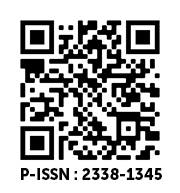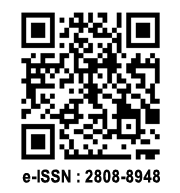Morphology, Nest Characters, and Behavior: Taxonomic Aids in Facilitating Identification of Tetragonula biroi Friese (Hymenoptera: Apidae: Meliponini)
DOI:
https://doi.org/10.36782/apjsafe.v11i1.204Keywords:
genus Tetragonula, stingless bee identification, Tetragonula biroi, PhilippinesAbstract
Tetragonula biroi Friese, the most popular stingless bee species in the Philippines, belongs to Tetragonula, a difficult genus to deal with due to the high character variability of workers. This paper provides a detailed description of the morphological characters, nest features, and behavioral characteristics of T. biroi to help facilitate its classification and identification. Proper identification of stingless bees is crucial in biodiversity conservation, genetic improvement, and pest management.
Downloads
References
Aidar, D.S. A mandaçaia - biologia de abelhas, manejo e multiplicação artificial de colônias de Melipona quadrifasciata Lep. (Hymenoptera, Apidae, Meliponinae). Sociedade Brasileira de Genética, 1996, 04.
Baltazar, C.R. A catalogue of Philippine Hymenoptera (with a bibliography, 1758-1963). Pacific Insects Monographs, 1966, 8, 1-488.
Belina-Aldemita, Ma.D., Opper, C.; Schreiner, M.,
D'Amico, S. Nutritional composition of pot- pollen produced by stingless bees (Tetragonula biroi Friese) from the Philippines. Journal of Food Composition and Analysis, 2019, 82, [3]103215. https://doi.org/10.1016/j.jfca.2019.04.003
Cervancia, C.R. & Fajardo, A.C. Stingless bees and
crop pollination in the Philippines. In: Roubik, D.W. (ed). The pollination of cultivated plants- A compendium for practitioners, 2018, 2, 65-69.
Couvillon, M.J., Wenseleers, T., Imperatriz-Fonseca, V.L., Noguiera-Neto P., & Ratnieks, F.L.W. Comparative study in stingless bees (Meliponini) demonstrates that nest entrance size predicts traffic and defensivity. Journal of Evolutionary Biology, 2008, 21, 194-201.
Dollin, A.E., Dollin, L.J., & Sakagami, S.F. Australian stingless bees of the genus Trigona (Hymenoptera: Apidae). Invertebrate Taxonomy, 1997, 11 (6), 861- 896.
Franck, P., Cameron, E.C., Good, G., Rasplus, J.Y., & Oldroyd, B. P. Nest architecture and genetic differentiation in a species complex of Australian stingless bees. Molecular Ecology, 2004, 13, 2317- 2331.
Friese, H. Die Trigona-Arten Australiens. Termeszetrajzi Fuzetek, 1898, 21 427-431.
Heard, T.A. Crop pollination using stingless bees in
Australia. In: Roubik, D.W. (ed). The pollination of cultivated plants- A compendium for practitioners, 2018, 2, 79-86.
Heard, T. A. The role of stingless bees in crop pollination. Annual Review of Entomology, 1999, 44, 183-
Hidalgo, H.A., Fresnido, M.B.R., Nicolas, A.R., Presto, P.B. The development of indicators for social enterprise business model in melitourism. Journal of Agribusiness Marketing, 2022, 9 (1), 23 pp.
Hidalgo, H.A., Nicolas, A.R., Cedon, R. Development barriers of stingless bee honey industry in Bicol, Philippines. Internationaal Journal on Advanced Science Engineering and Information Technology, 2020, 10 (3), 1245-1251.
Hubbell, S.P. & Johnson, L.K. Competition and nest spacing in a tropical stingless bee community. Ecology, 1977, 58, 949-963.
Martins, C.F.; Cortopassi-Laurino, M.; Koedam, D.; & Imperatriz-Fonseca, V.L. Tree species used for nidification by stingless bees in Brazilian Caatinga. Biota Neotropica, 2004.
Michener, C.D. The bees of the world. Johns Hopkins University Press,Baltimore, 2000, xiv (1), 913.
Michener, C.D. Classification of the Apidae (Hymenoptera). Appendix. Trigona genalis Friese, a hitherto unplaced New Guinea species. University of Kansas Science Bulletin, 1990, 54,75-163.
Michener, C.D. Observations on the nests and behavior of Trigona in Australia and New Guinea (Hymenoptera: Apidae). American Museum Novitates, 1961, 1-46.
Mostoles, Ma.D.J.M. Community-based approach to sustainable stingless beekeeping in Sorsogon, Philippines. SEARCA Agriculture and Development Paper Series, 2018, No. 2018-4.
Nicolas, A.R. (2013). Taxonomy of Philippine stingless bees of the genus Tetragonula Moure (Hymenoptera: Apidae: Meliponini). DOST ScINET-PHIL. http://scinet.dost.gov.ph.
Nicolas, A.R.; Hidalgo, H.A.; Fresnido, M.B.R. Melitourism Potential of Bali, Indonesia and Bicol, Philippines. Asia Pacific Journal of Sustainable Agriculture Food and Energy, 2020, 10 (1), 8-14.
Rasmussen, C. Catalog of the Indo-Malayan/Australasian Stingless Bees (Hymenoptera: Apidae: Meliponini). Zootaxa (1935). Magnolia Press, New Zealand, 2008, 80 pp.
Rebaya, Joseph R. Nest architecture of stingless bees,
Tetragonula biroi Friese (Hymenoptera: Apidae: Meliponini). Central Bicol State University of Agriculture, Pili, Camarines Sur. Undergraduate Thesis, 2015, 38 pp.
Roubik, D.W. Stingless bee nesting ecology. Apidologie, 2006, 37, 124-143.
Roubik D.W. Wild bees of Brunei Darussalem. In: Edwards D.S., Booth W.E., Choy S.C. (Eds.). Tropical Rainforest Research-Current Issues. Kluwer Academic Publishers, London, 1996, 56-66.
Roubik, D.W. Ecology and Natural History of Tropical Bees. Cambridge University Press, Cambridge, 1989, 514 pp.
Roubik, D.W.; Heard, T.A.;& Kwapong, P. Stingless
bee colonies and pollination. In: Roubik, D.W. (ed). The pollination of cultivated plants- A compendium for practitioners, 2018, 2, 39-58.
Sakagami, S.F. Tetragonula stingless bees of the continental Asia and Sri Lanka. Journal of the Faculty of Science, Hokkaido University Series VI-Zoology, 1978, 21, 165-247.
Sakagami, S.F. & Inoue, T. Taxonomic notes on three bicolorous Tetragonula stingless bees in Southeast Asia. Kontyu, 1985, 53,174-189.
Sakagami, S.F.; Inoue, T.; Yamane, S.; & Salmah, S. Nest architecture and colony composition of the Sumatran stingless bee Trigona (Tetragonula) laeviceps. Kontyu, 1983, 51,100-111.
Salmah, S.; Inoue, T.; & Sakagami, S.F. An analysis of apid bee richness (Apidae) in central Sumatra. In: S.F. Sakagami, R. Ohgushi & D.W. Roubik (Eds.). Natural history of social wasps and bees in equatorial Sumatra. Hokkaido University Press, Sapporo, 1990, 139-174.
Schwarz, H.F. The Indo-Malayan species of Trigona. Bulletin of the American Museum of Natural History, 1939, 76, 83-141.
Shanahan, M. & Spivak, M. Resin use of stingless bees: A review. Insects, 2021, Vol. 12 (8). 719 pp.
Starr, C.K. & Sakagami S.F. An extraordinary concentration of stingless bee colonies in the Philippines, with notes on nest structure (Hymenoptera: Apidae: Trigona spp.). Insectes Sociaux,1987, 34, 96-107.
Souza, B.A.; Carvalho, C.A.L.; & Alves, R.M.O. Notas sobre a bionomia de Melipona asilvai (Apidae: Meliponini) como subsídio à sua criação racional. Arch. Zootec., 2008, 57, 53-62.
Suarez, A.F.L.; Tirador, A.D.G.; Villorente, Z.M.;
Bagarinao, C.F.; Sollesta, J.V.N.; Dumancas, G.G.; Sun, Z.; Zhan, Z.Q.; Saludes, J.P.; Dalisay, D.S. The isorhamnetin-containing fraction of Philippine honey produced by the stingless bee Tetragonula biroi is an antibiotic against multidrug-resistant Staphylococcus aureus. Molecules, 2021, 26 (6), 1688.
Wille, A. & Michener, C.D. 1973. The nest architecture of stingless bees with special reference to those of Costa Rica. Revista de Biologica Tropical, 1973, 21 (supl.), 9-278.









